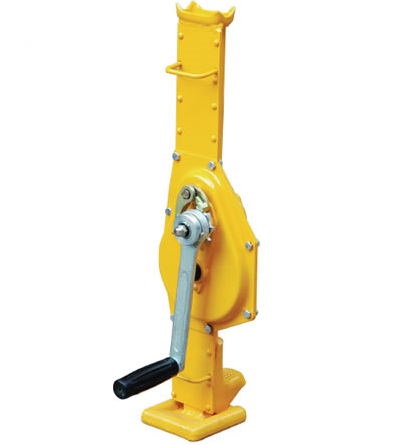
The difference between mechanical jack and hydraulic jack
Keyword:mechanical jack Time:2019-11-8 13:09:03
The difference between mechanical jack and hydraulic jack
Hydraulic jack is the simplest lifting equipment with small lifting height. It has two types: mechanical and hydraulic. Mechanical Jack has rack type and spiral type. Because of its small lifting weight and laborious operation, it is generally only used for mechanical maintenance, but not suitable for bridge repair. Hydraulic jack is widely used because of its compact structure, smooth operation and self-locking function. Its shortcomings are limited lifting height and slow lifting speed.
When the ultra-thin hydraulic jack is in use, its internal piston will have greater momentum because of inertia. In order to reduce the mechanical impact of the moving parts with larger momentum when they reach the end of the journey, it will violate the cylinder head, affect the accuracy of the ultra-thin hydraulic jack and damage the ultra-thin hydraulic jack, then we will. It is necessary to set up the buffer device of the ultra-thin hydraulic jack.
Next, we will give you a brief introduction about the analysis of internal buffer equipment of ultra-thin hydraulic jack.
A. Unloading type, which means that when the piston moves close to the cylinder head, the valve stem of the bidirectional buffer valve first touches the cylinder head, and the valve stem is pushed away from the sealing seat along the axis. The two chambers of the hydraulic cylinder communicate with each other through the opening of the buffer valve, and the pressure difference between the two chambers of the cylinder decreases rapidly to achieve buffer.
B. Throttle means that when the piston of the hydraulic cylinder moves close to the cylinder head, all or part of the oil in the low-pressure return chamber generates back pressure to form resistance through fixed throttle or variable throttle, so as to reduce the cushioning effect of the piston movement speed.
Hydraulic jack is composed of shell, big piston, small piston, wrench, oil tank and other components. The working principle is that the wrench moves upward to drive the small piston upward. The oil in the tank is sucked into the lower part of the small piston through the tubing and one-way valve. When the wrench presses down, the small piston is driven downward. The oil in the lower part of the tank and the small piston is blocked by the one-way valve. The oil in the lower part of the small piston is pressed into the lower part of the big piston through the inner oil path and the one-way valve. Because of the lever action, the lower pressure of the small piston increases tens of times, and the area of the large piston is tens of times that of the small piston. The oil pressure produced manually is squeezed into the large piston. According to Pascal's principle, the area ratio of the big piston to the big piston is the same as the pressure ratio.
Classification of mechanical jacks: Mechanical hydraulic jacks are suitable for various lifting operations with small lifting height. Hydraulic ultra-thin hydraulic jack is composed of cylinder, oil pump, oil tank, piston, rocker handle, joint and other main parts.
When the mechanical jack works, as long as the swing handle is switched back and forth, the manual oil pump keeps pressing oil into the cylinder. As the oil pressure in the cylinder keeps increasing, the piston and the weight above the piston are forced to move upward together. When the return valve is opened, the high-pressure oil in the cylinder will flow back to the oil storage chamber, and the weight and the piston will fall together. If the oil quantity of manual pump body is insufficient, N33 # hydraulic oil filtered sufficiently must be added to the pump before it can work.


- No information
-
1. Design objective of electronic crane scale network management. (1) Adopt advanced distributed data processing techno…
-
Electronic crane scale bearing platform installation to focus Electronic crane scale can be installed generally on the li…


